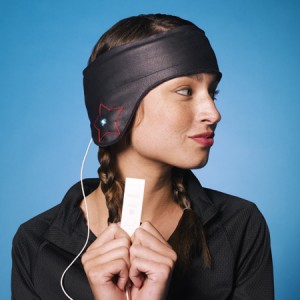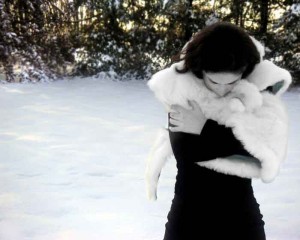In my personal experience of working with and teaching fashion technology and electronic craft, I have found the artisans are mostly women. While there are many men dominating the wearable technology field, in the task-focused integration of technology and clothing there are a great deal of woman who work with technology for aesthetic, artistic, and fashionable purposes.In my personal experience of working with and teaching fashion technology and electronic craft, I have found the artisans are mostly women. While there are many men dominating the wearable technology field, in the task-focused integration of technology and clothing there are a great deal of woman who work with technology for aesthetic, artistic, and fashionable purposes. This did not strike me as interesting at first, however this changed when I learned that all of the featured artists in the Coded Cloth exhibition are female. Presenting only female artists was not the original intent, but it simply worked out that way. Why?
From the grandmother of electronic fabric integration, Maggie Orth, to the artistic expressions of online crafters today like Syuzi Pakhchyan, and fringe fashion designers like Di Mainstone – the majority of people working in this type of electronic medium are women. Here, I am defining the medium loosely as work which integrates electronics using, or inspired by, traditional approaches such as sewing, weaving or even growing the materials.
This medium is about design and making, and I seek to understand the basic want to integrate electronics into design, art, clothing and craft from a female perspective. In my search I’ve found that there are some common threads that connect many female electronic makers and craftswomen. There is a relationship to the history of craft, an interest in fashion or fashion theory, and a want to create designs with the possibility of an intimate relationship with the wearer or participants.
Most women are introduced to craft at an early stage in life, and are inspired and taught by grandmothers, mothers, or by a mentor at a camp or school. Wherever learned, it is something that is passed down to them. We have all seen the women in our lives sew, stitch, knit, crochet, build, appliqué and craft with their hands even if we did not end up doing it ourselves. There is a piece of us that understands that creating and working towards an aesthetically beautiful object is part of our female nature and heritage. There is something about the process of working with fabrics and clothing in our gender that we remember and generally want to connect with. While this point of view may seem naïve or nostalgic to some, it doesn’t make it any less worthwhile. Our memories and experiences are as much a part of us as the blood that runs through our veins, and for most women, this means a connection with a creative spirit of our past.
However, we do not live in the past. We live today in a world of gadgets, wireless connections and technologies our foremothers never dreamed of. We have the opportunity to be inspired by these technologies and explore how they are integrated into our lives. The old ways and the new are mixing into a wonderful exploration of technological art, fashion and design. For some, like artists Gina Matchitt and Alyce Santoro, the craft itself has become the main objective. We see work that aims to converge ancient ways with modern tools, and materials to speak new meanings or recall historic ones. For others, like Angel Chang, it is more about a larger social agenda of fashion with a focus on technological materials used in approachable and aesthetic fashions for the modern woman.
This larger cultural fashion institution is also a majority female spectrum. Any tabloid, magazine or pop culture blog with female readers knows the passion women have for clothing and fashion. So, it stands to reason that many of the women who end up working in technological fashion or design were originally influenced by some of the most basic fashion theories such as identity, gender, social status, and personal expression. For them, like in the Hidden clothing line by High Tea With Mrs Woo that deals with erogenous zones, it can be inferred that technology allows a deeper connection with the roots of fashion. In particular, it allows for a social agenda involving the intimate connection with the body and the outside world, exploring the intersection between body, identity and culture.
This connection to the body – the soft, tangible interface in technologically inspired or infused fabrics – allows artists to conceive work that physically connects with other human beings. It has been my experience that this is one of the major factors attracting the female following. In fact, one of the first projects students tend to make when starting out with electronic textiles or fashionable technology is one based on emotion. They might do this by expressing emotion to others with an emotionally responsive garment or a wearable emotion indicator. By focusing the efforts on principles outside of typical technological functional necessities, such as medical care, research and networking, technology becomes less of an end product and more of a conduit for our inspiration and social desires. This can be seen in artists like Despina Papadopoulos and Elena Corchero, whose idea of bringing us closer to one another by building upon our relationships, is the cornerstone for working with electronic textiles.
In the end, most of us build upon the skills we have learned, the technologies we live with, and the relationships we want to affect — female or not. It appears that in the realm of electronics and textiles specifically, that these attributes have come together in attracting women to the blossoming medium through art and design. With the complex intermix of technology with physicality, tactility and wearablity, we find a rewarding place to explore our love for fashion, intimate relationships and craft.
Alison Lewis
Alison Lewis is a designer and author with a passion for fashion, beauty and technology. She is the author of “Switch Craft” Battery Powered Crafts to Make and Sew,” the first craft and technology book for mainstream sewers and crafters which teaches how to integrate technology into their designs. Alison is also the creator and producer of SWITCH (www.iheartswitch.com), an online DIY blog that showcases technology as modern, crafty, fashionable and fun. Alison holds a graduate degree from Parsons School of Design where she teaches fashion technology and fashion communication. As the electronic and media specialist at Art Guild Inc., she integrates movement, sound, and light into museum and exhibit design. In her spare time, when Alison isn’t exploring New York City boutiques, she is the techno-fashionista guru for Verizon FiOS’s television show MyHome2.0.
Read More
 This work is licensed under a Creative Commons Attribution-NonCommercial-ShareAlike 2.5 Australia.
This work is licensed under a Creative Commons Attribution-NonCommercial-ShareAlike 2.5 Australia.









Alison-
As flattered as I am by being called d the grandmother of the field- I prefer mother- I am just no that old!!!!! :))))
Maggie